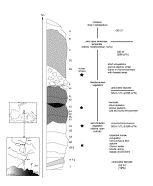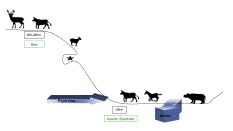Insights from stable isotope analyses in Payre (Ardèche, southeastern France)
Michaela Ecker, Hervé Bocherens, Marie-Anne Julien, Florent Rivals, Jean-Paul Raynal, Marie-Hélène Moncel
Source - http://www.sciencedirect.com/science/article/pii/S0047248413001590
Journal of Human Evolution
Abstract
The Middle Palaeolithic site of Payre in southeastern France yields abundant archaeological material associated with fossil hominid remains. With its long sequence of Middle Pleistocene deposits, Payre is a key site to study the Middle Palaeolithic chronology of this region. This study is the first to investigate carbon and oxygen isotope contents of Neanderthal tooth enamel bioapatite, together with a wide range of herbivorous and carnivorous species. The aim is to contribute to the understanding of hunting behaviour, resource partitioning, diet and habitat use of animals and Neanderthals through a palaeoecological reconstruction.
Local topography had a visible influence on carbon and oxygen stable isotope values recorded in herbivore tooth enamel. This was used to investigate possible habitats of herbivores. The different herbivorous species do not show large variations of their carbon and oxygen isotope values through time, indicating niche conservatism from OIS 8–7 to OIS 6–5, i.e., independently of palaeoclimatic and palaeoenvironmental variations. Based on these new observations, we conclude that Neanderthals employed a stable subsistence strategy over time, using a variety of local resources, with resource partitioning visible between humans and carnivores, especially wolves.
A comparison of the results of stable isotopic investigation with the results of tooth wear analyses previously conducted on the same teeth allowed us to demonstrate that grazing and browsing do not bind animals to a specific habitat in a C3 environment as reflected in the isotopic values.

Figure 1. Location of Payre and the chronostratigraphy of the archaeological layers (modified from Rivals et al., 2009).

Figure 3. Reconstruction of ungulate distribution in the landscape surrounding the site of Payre (indicated by the star) based on enamel carbonate δ13C and δ18O values and compared to lithic resources distribution. Horse, rhinoceros and large bovids fed in the Rhône Valley; red deer and large bovids on the limestone plateaus; tahr and chamois fed on the slopes. Main prey species of Neanderthals were horse, red deer and large bovids.